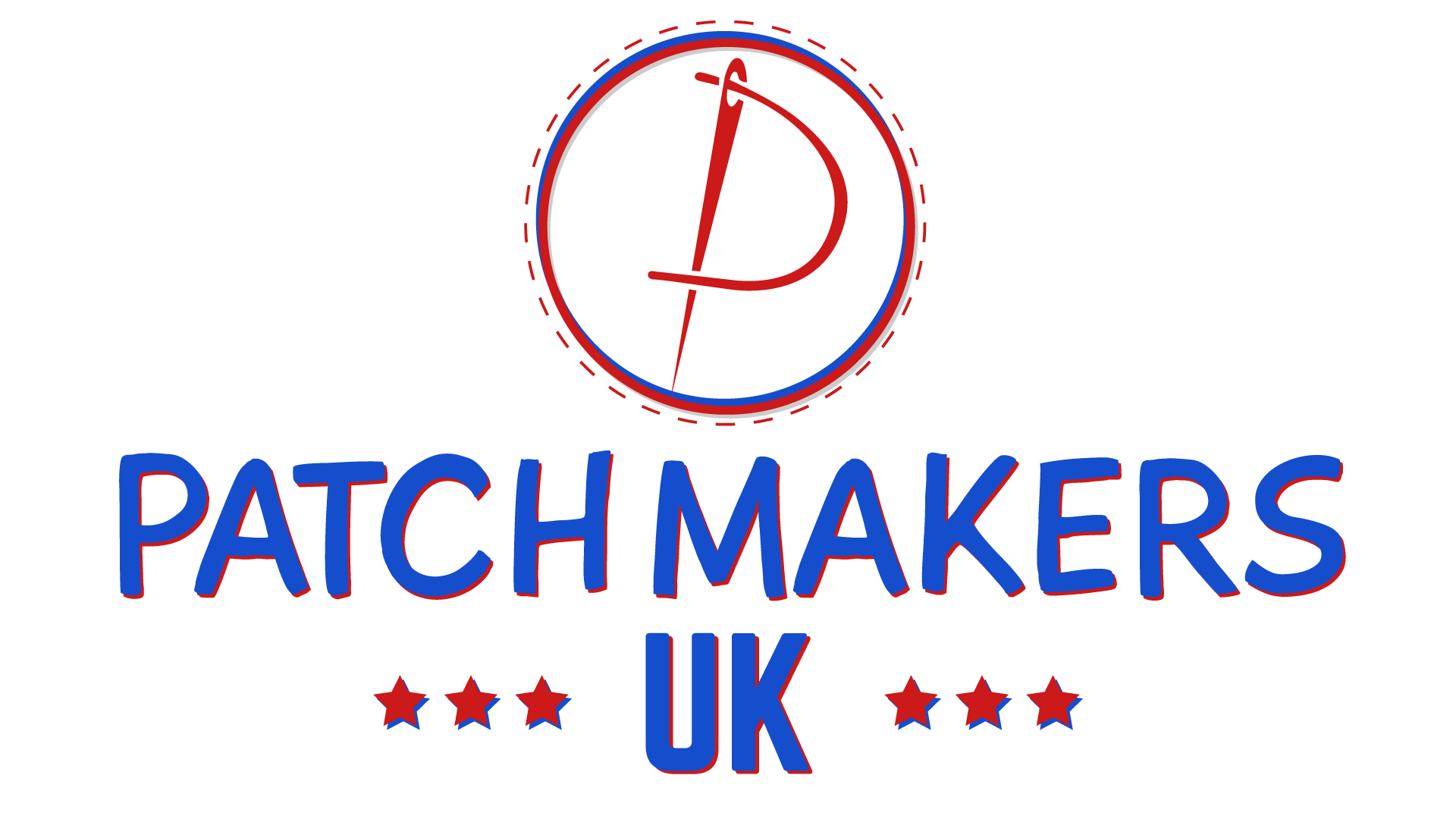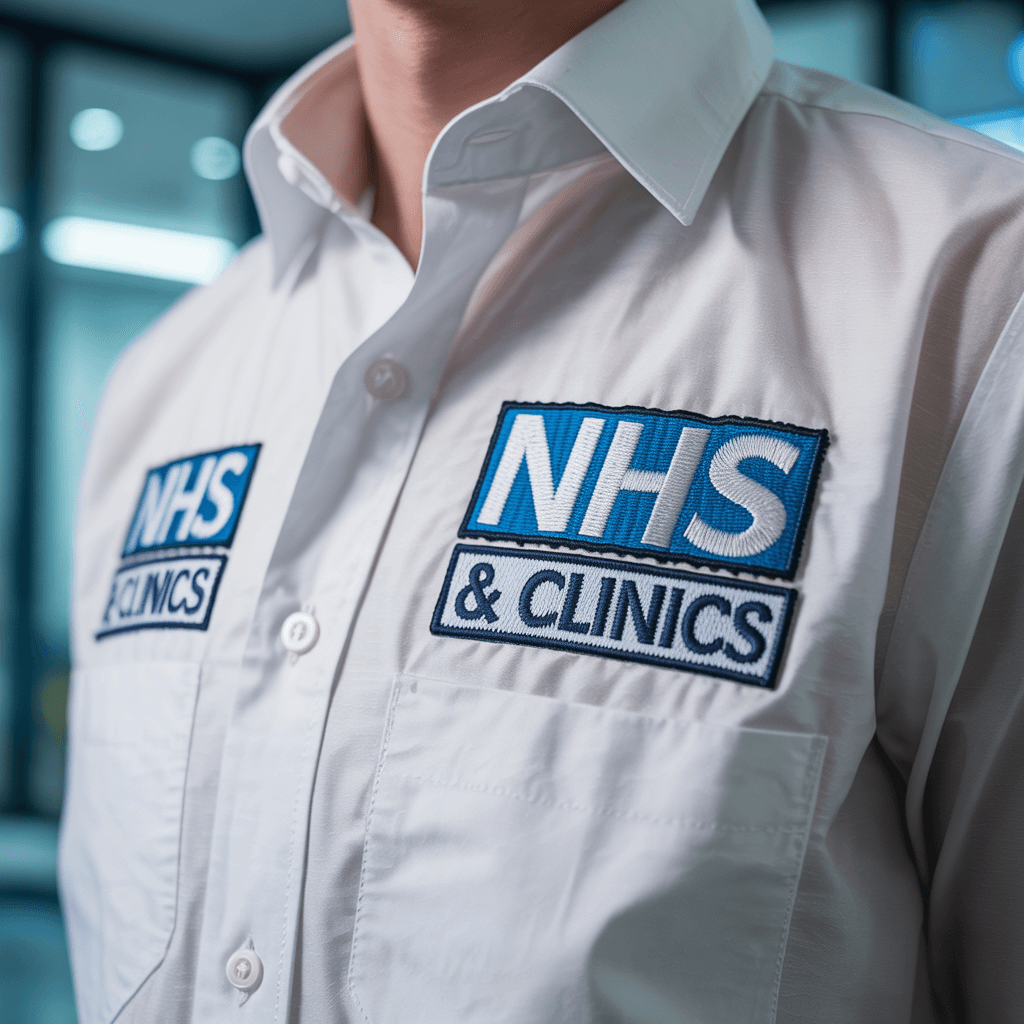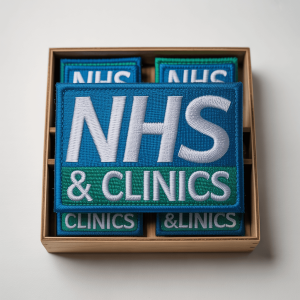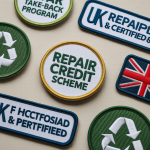If your patches can’t survive the laundry or play nice with infection-control protocols, they don’t belong anywhere near a uniform. Healthcare-ready patches are a small detail that carry big weight, brand trust, staff safety, and compliance all stitched into one neat rectangle (or circle… or shield).
If you’re NHS, ambulance services, or a private clinic looking for Healthcare-Ready Patches, this is your quick guide to getting them right: materials, attachment methods, wash cycles, and all the infection-control bits the auditors love.
Why Healthcare-Ready Patches Are a Big Deal
In a hospital or ambulance bay, uniforms do serious graft. They get splashed, scrubbed, and laundered hard. A cheap patch that curls, cracks, sheds threads, or harbours bacteria? No thanks. You need Custom Patches that:
- Endure industrial wash temperatures and frequent cycles
- Resist delamination, dye bleed, and thread fluff
- Don’t compromise infection control or patient perception
- Keep branding consistent across departments and seasons
That’s where a best patch maker really earns the badge, spec-driven manufacturing, healthcare-grade adhesives, stable dyes, and clean edge finishing.
Infection Control Comes First (Obviously)
Uniform patches can’t become little germ hotels. Your spec should prioritise:
- Non-porous or tight-weave faces (PVC, woven, printed) for high-contact roles
- Heat-tolerant construction to survive wash disinfection cycles
- Edge sealing (merrowed border or heat-cut) to reduce lint and micro-nooks
- Medical-grade adhesives or stitch plans that won’t loosen under heat or chemicals
If you’re writing a procurement brief, include wash temp requirements, disinfectant exposure, and a minimum cycle count (e.g., “maintain appearance and adhesion after 50 industrial washes at 60–75°C”).
For laundry-care specifics, our guide walks through the do’s and don’ts without voiding your warranty or your sanity: How to Wash Custom Patches Without Damage | Expert Guide UK.
Materials That Behave Under Pressure
Different patch styles suit different roles and laundering regimes. Shortlist like this:
- PVC (Custom PVC Patches): Non-porous, wipe-clean, highly durable; spot-clean friendly and solid in repeated washes. Great for paramedics and facilities teams.
- Woven (Custom Woven Patches): Tight weave, crisp detail for small text (perfect for wards with role titles). Washes well, minimal bulk.
- Embroidered (Custom Embroidered Patches): Premium texture, hospital heritage vibe; ensure colourfast threads and sealed edges for infection control.
- Printed/Sublimated (Custom Printed / Custom Sublimated Patches): Photographic clarity for complex logos; choose healthcare-safe inks and top-coats with heat stability.
- Leather/Bullion/Sequin/Chenille: Glam, but not ideal for clinical zones. Save these for fundraising crews, gift shops, or Custom Patches for events.
Attachment Methods That Don’t Give Up
- Sew-on patches for clothes: Best for high-temp laundering; nothing to melt, nothing to shift.
- Custom iron on patches: Fine for admin jackets and reception wear; confirm adhesive’s melt point vs wash temp.
- Hook-and-loop (Velcro) backs: Brilliant for role-swap badges (“Nurse in Charge”, “Student Nurse”, “HCA”). Ensure perimeter stitching + rounded corners.
- Hybrid (Sew + Adhesive): Belt-and-braces for outerwear and kit bags.
If you rely on custom logo patches for jackets, custom logo patches for hats, or custom logo patches for bags, spec the attachment per garment fabric and wash regime, poly-cotton scrubs are not the same world as softshell ambulance jackets.
Wash Cycles: What to Put in Your Spec
Healthcare laundry is not gentle. Build your brief around:
- Temperature: 60–75°C typical for disinfection; patches must remain intact and colourfast.
- Detergents & Disinfectants: Alkaline detergents + oxidising agents; inks and adhesives must be chemical-resistant.
- Cycle Count: Ask for test evidence (e.g., 50–75 industrial cycles).
- Drying: Tumble or tunnel finishing, confirm adhesive and edge finish tolerate it.
- Inspection: No fraying, peeling, warping, or dye bleed permitted post-test.
Use Cases Across the Health Ecosystem
- NHS Trusts: Department identifiers, role titles, ward branding, custom employee name patches for workwear, bulk custom patches for uniforms, and corporate logo patches UK made for estates teams.
- Ambulance/Paramedics: Hi-vis outerwear patches, reflective elements, and custom PVC patches for wipe-down. Hook-and-loop for role swaps.
- Private Clinics: Front-of-house polish, personalised embroidery patches and personalised iron on patches for brand-consistent, smart uniforms.
- Universities & Training: School mascot patch for health schools, student cohorts, and placements.
- Events & Fundraising: Custom patches for festivals, custom patches for Easter/Christmas/thanksgiving (yes, UK teams do seasonal charity drives).
- Security & Facilities: Custom military patches UK styling, but in hospital-safe materials.
Speed, Volume & Budget
Whether you need bulk patches, want Custom Patches at Low Prices, or simply buy custom patches online for a single team, we’ve got tiers that scale. If you’re asking, “how much do custom patches cost?”, it depends on size, type, stitch count/coverage, backing, and edge finish. For NHS frameworks or private-group procurement, we’ll quote fast and stick to it.
If your uniform apparel includes gloves and PPE, we also supply durable branding solutions tailored to gloves: Get UK’s High-Quality Custom Patches for All Types of Gloves.
Role-Ready Choices (Who Should Use What?)
- Ward Nurses / HCAs / Theatre Teams: Woven or embroidered with sew-on backing. Clean lines, no fluff.
- Paramedics / Rapid Response: PVC or printed with hook-and-loop. Reflective optional.
- Admin / Reception: Embroidered or woven iron-on for smart blazers and cardigans.
- Facilities / Estates / Security: PVC or woven, reinforced stitching for abrasion.
- Student & Volunteer Programmes: personalised embroidered patches or personalised clothing patches, cost-effective and brand-consistent.
Design Tips That Sail Through Laundry
- Keep details bold. Fine lines fade faster than you think.
- Rounded corners. Less snagging, less fray, cleaner look.
- Contrast counts. Theatre lighting and night shifts aren’t kind to pale-on-pale.
- Specify Pantones. NHS blues and greens need to match across suppliers.
- Label your backing in the PO. “Sew-on only” prevents the wrong adhesive at scale.
- Add a micro QR? For asset tracking on kit bags,talk to us about Custom Printed Patches.
FAQs
What makes a patch “healthcare-ready”?
Patches built for high-temp washes, sealed edges, colourfast dyes, and secure backing (sew/Velcro) that won’t harbour bacteria or peel under disinfection.
Are embroidered patches safe for NHS infection control?
Yes, when edge-sealed, colourfast, and securely sewn. For wipe-clean needs (ambulance/facilities), PVC or printed with a smooth face is often better.
Which patch types handle frequent hot washes best?
Woven, embroidered, and PVC patches with sealed edges. Always confirm test data for 60–75°C and 50+ industrial cycles.
What backing is best for hospital uniforms?
Sew-on for the highest wash durability. Hook-and-loop (Velcro) is great for role-swap badges. Iron-on is fine for admin wear if the adhesive is rated for heat.
Do patches affect the breathability of scrubs?
Minimal impact when sized sensibly and placed away from high-sweat zones. Woven or printed patches keep bulk low.
Will patch colours bleed onto uniforms?
Not if they’re made with healthcare-safe, colourfast threads/inks. Ask for certified colourfastness and chemical-resistance results.
How should we wash uniforms with patches?
Follow trust/clinic laundering guidance. Generally: hot cycle (per policy), avoid harsh chlorine where possible, and inspect for fray/peel, replace if compromised.
Can we use reflective or high-vis patches for paramedics?
Yes. Choose PVC or printed patches with reflective film and hook-and-loop backing for easy swap-outs on outerwear.
What’s the ideal patch edge for infection control?
Rounded corners and a merrowed or heat-cut sealed edge to minimise lint traps and snagging.
How do we spec patches for procurement?
State patch type, size, backing, edge finish, Pantone match, and wash/chemical testing (e.g., 50–75 hot cycles without delamination or bleed).
Are leather, bullion or chenille patches suitable for clinical areas?
Generally no, save these for fundraising, retail or off-ward apparel. Use smooth, tight-weave or PVC for clinical zones.
What’s the lead time for large NHS orders?
Typically 1–3 weeks depending on volume and type, with rush options available. Ask for proofs and a colour sample before production.
Ready to Spec Your Healthcare-Ready Patches?
Whether it’s a single department rollout or a trust-wide rebrand, we’ll help you get your custom patches right, built for real-world wash cycles and infection control. Order custom embroidered patches UK, buy patches online, or chat through a framework-friendly quote today. Let’s get your uniforms sorted with the Patch Makers UK team.







